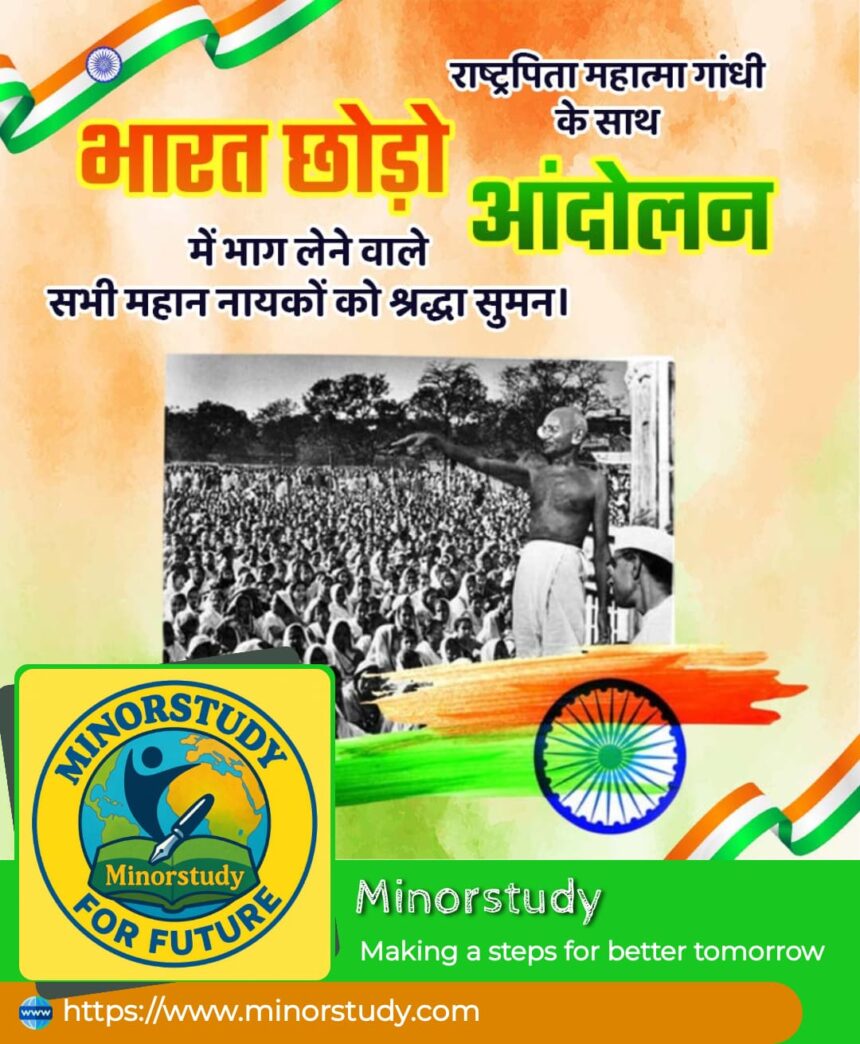Tribute to the Brave Heroes of the Quit India Movement – A Turning Point in India’s Freedom Struggle
The Quit India Movement, launched on 8 August 1942 under the leadership of Mahatma Gandhi, was one of the most intense and decisive phases of India’s fight for independence. It was not just a political movement but a mass awakening—calling every Indian, regardless of caste, creed, gender, or age, to rise against British rule. This was the moment when the nation united as one voice and declared, “Do or Die.”
- History of the Quit India Movement
- Key Facts about the Quit India Movement
- Timeline of the Quit India Movement
- Significance of the Quit India Movement
- How the Movement is Observed Today
- Wishing on Quit India Day
- Importance in Our Life Today
- Frequently Asked Questions (FAQs)
- Important Points to Remember
- Conclusion – Daily Life Impacts of the Quit India Movement
Today, as we pay tribute to all the great heroes who participated in this historic movement, we must remember that their courage, sacrifices, and determination paved the way for the India we live in today.
History of the Quit India Movement
The roots of the Quit India Movement lie in the growing frustration of Indians with the British government’s unwillingness to grant independence. The Second World War had intensified the political crisis. The British dragged India into the war without consulting Indian leaders, which fueled public anger.
In March 1942, the Cripps Mission arrived with promises of granting dominion status after the war, but its proposals fell far short of India’s aspirations. Mahatma Gandhi declared that India could no longer wait—freedom had to be immediate.
On 8 August 1942, at the Gowalia Tank Maidan (now August Kranti Maidan) in Mumbai, Gandhi gave his iconic speech, urging Indians to follow the path of non-violent civil disobedience until the British left India.
Key Facts about the Quit India Movement
Launch Date: 8 August 1942.
Leader: Mahatma Gandhi, supported by leaders like Jawaharlal Nehru, Sardar Vallabhbhai Patel, Maulana Azad, Aruna Asaf Ali, and many more.
Main Slogan: “Quit India” and “Do or Die.”
Immediate Impact: Within hours of the launch, top Congress leaders were arrested.
Public Participation: Students, farmers, laborers, women, and youth took active roles.
Women Leaders: Aruna Asaf Ali famously hoisted the Indian flag at Gowalia Tank Maidan despite police threats.
Violent Outbreaks: Though Gandhi advocated non-violence, protests turned violent in some areas due to police brutality.
Underground Networks: Leaders like Jayaprakash Narayan and Ram Manohar Lohia worked underground to spread the movement.
British Reaction: Brutal suppression, mass arrests, censorship, and police firing.
Legacy: The movement marked the beginning of the end for British colonial rule in India.
Timeline of the Quit India Movement
March 1942: Cripps Mission arrives in India.
8 August 1942: Quit India Resolution passed at Bombay Session of the All India Congress Committee.
9 August 1942: Gandhi and other top leaders arrested; Aruna Asaf Ali hoists the national flag.
August–September 1942: Protests erupt across India; railway stations, telegraph lines, and government offices targeted.
1943–1944: Underground resistance continues despite heavy British crackdown.
1945: World War II ends, and the British begin serious negotiations for Indian independence.
Significance of the Quit India Movement
Mass Mobilization: For the first time, millions of Indians—students, women, workers, peasants—participated actively in the freedom struggle.
Global Impact: The movement showcased India’s determination to the world, especially when Britain was already weakened by World War II.
Unity in Diversity: People from all religions, regions, and backgrounds came together with one goal—independence.
Final Push: Though independence came in 1947, historians agree that the Quit India Movement was the final nail in the coffin of British rule.
How the Movement is Observed Today
Quit India Day is observed every 8 August across India. Schools, colleges, and government offices organize:
Flag-hoisting ceremonies
Speeches and debates on freedom fighters
Documentary screenings about 1942 events
Tribute marches in memory of the heroes
Wishing on Quit India Day
You can share messages such as:
“Salute to the fearless hearts who gave everything for our independence.”
“Let’s honor the Quit India heroes by working for a stronger, united, and corruption-free India.”
“Do or Die spirit of 1942 still inspires us today.”
Importance in Our Life Today
The spirit of the Quit India Movement still holds relevance in modern India:
Unity in Crisis: Teaches us the importance of staying united in challenging times.
Courage to Stand Up: Inspires us to speak against injustice.
Non-Violent Resistance: Shows that peaceful protest can bring about monumental change.
Nation First: Encourages selflessness for the greater good of the country.
Frequently Asked Questions (FAQs)
Q1. Who started the Quit India Movement?
Mahatma Gandhi launched it on 8 August 1942 at Mumbai.
Q2. What was the main slogan of the movement?
“Do or Die.”
Q3. Was the movement entirely non-violent?
It was intended to be non-violent, but some protests turned violent due to police action.
Q4. What was the role of women in the movement?
Women leaders like Aruna Asaf Ali, Sucheta Kripalani, and Usha Mehta played key roles.
Q5. What was the British response?
They arrested leaders immediately, censored the press, and used force to suppress protests.
Important Points to Remember
Quit India Movement = mass civil disobedience.
Date: 8 August 1942.
Place of origin: Gowalia Tank Maidan, Mumbai.
Result: Strengthened the call for independence.
Conclusion – Daily Life Impacts of the Quit India Movement
The Quit India Movement wasn’t just an episode in history—it was a lesson in unity, resilience, and courage. It tells us that when ordinary people come together with extraordinary determination, no empire—however mighty—can suppress them.
In our daily lives, this spirit can inspire us to stand united against corruption, injustice, and social evils. Just as the heroes of 1942 fought for India’s freedom, we can fight for a better, more equitable, and more progressive India.








